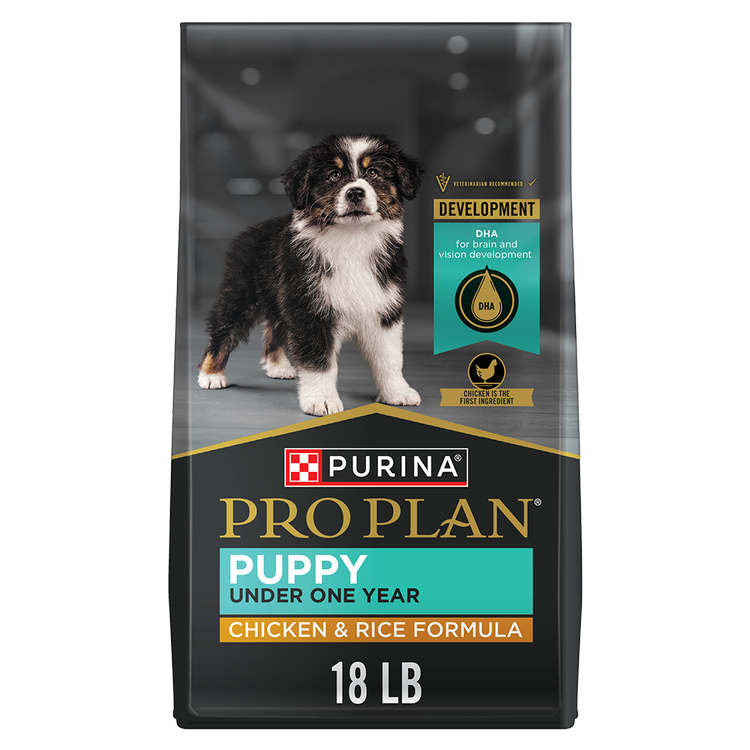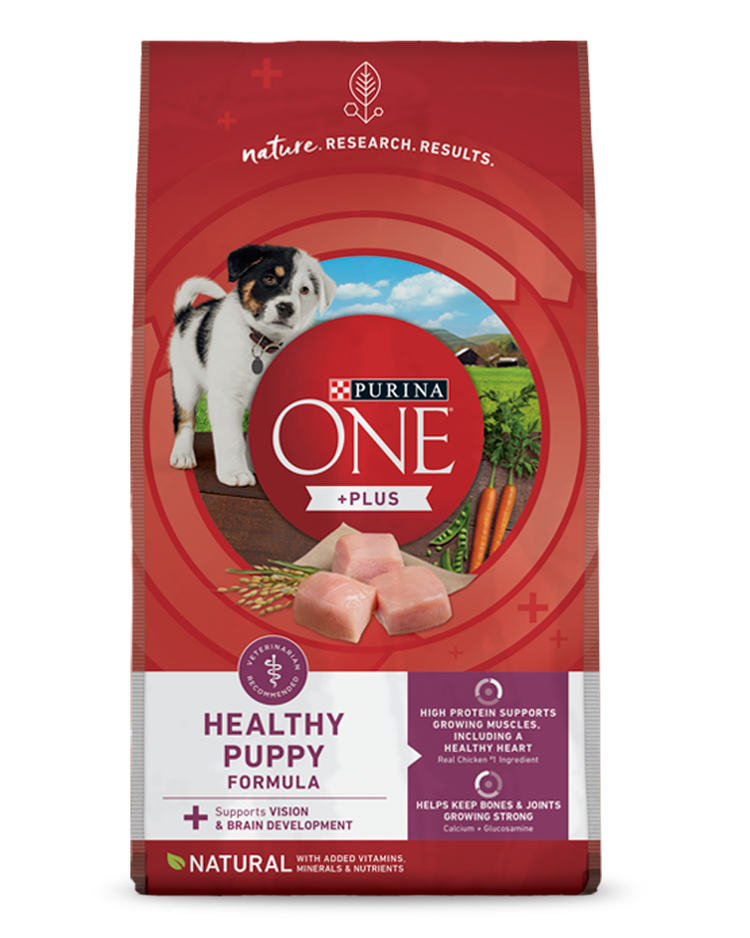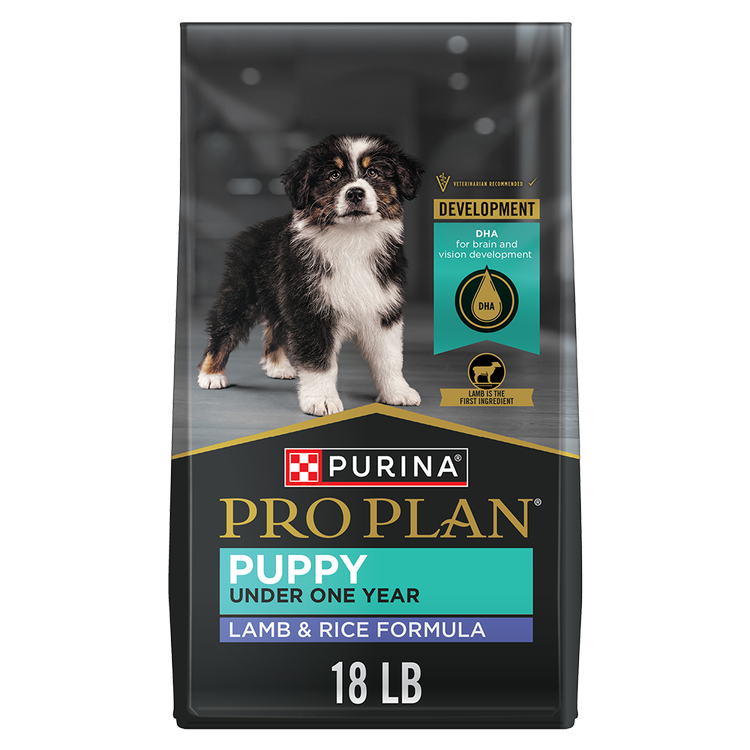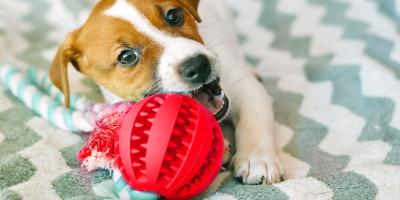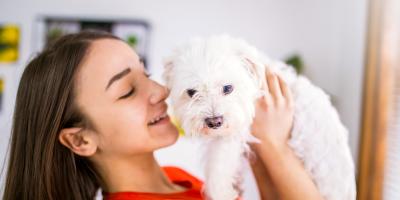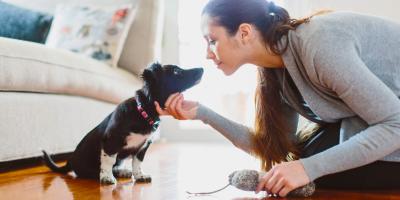Puppy Training: How & When to Potty Train a Puppy

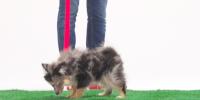
Puppy potty training is important. Not only will it save your floors, but it’s an essential step in teaching your puppy to be a good canine citizen.
A complete and balanced puppy food, as well as consistent mealtimes and planned potty breaks, are the keys to successful potty training. This will teach your puppy when to expect potty breaks and allow you to learn your puppy’s cues when they have to go.
So, if you’re wondering how to potty train a puppy, read on for expert tips from Dr. Ragen T.S. McGowan, PhD, a behavior scientist at Purina.
You can also view our “How to Potty Train Your Puppy” video from the MyPurina app.
How to Potty Train a Puppy – an Overview
Follow these instructions to potty train your puppy:
- Take your puppy outside at the same times every day
- Reward with treats and praise when they go potty in the right place
- Avoid accidents by keeping your puppy leashed and by your side
- When unsupervised, create a restricted space for them
- Watch for signs that your dog needs to go out
- Don’t punish your puppy for accidents
When to Start Potty Training a Puppy
Once you’ve studied up on how to house-train a puppy, the logical next question is, When? Like puppy obedience training, start potty training your pet as soon as they reach the appropriate developmental stage.
The ideal time to start house-training puppies is as soon as you bring them home, which for most people is between 8 to 12 weeks. While your puppy may have to go potty frequently (and there may be more accidents), establishing a routine early is important. By 12 to 16 weeks, your pet should have more bladder and bowel control.
“Remember, it’s never too late to potty train,” says Dr. McGowan. “If your pet joined your family as an adult dog, it may take a bit longer to transition them away from old habits, depending on their past experiences.”
Take them right to the area outside where you want them to go potty. Let them sniff around and get familiar with the area and give lots of praise as a reward immediately when they go potty in that spot.
“Make a big production out of it with verbal cues like ‘good potty!’ and an excited tone of voice and/or give them some tasty treats,” recommends Dr. McGowan. “The more excited you are about your puppy going potty outside, the quicker they’ll learn it’s a good thing.”
What is the Best Way to Potty Train a Puppy?
If you want to know how to house-train a puppy, remember consistency, attentiveness and patience are key. Establishing a routine will make potty breaks more predictable for your puppy, and they’ll learn when to expect to go outside.
Watching them for cues when they need to go out will also help minimize the chances for accidents in the house. Remember to keep things positive and fun.
Dr. McGowan recommends confining your puppy to a defined space when you cannot supervise them or watch their cues.
“It can be helpful to use a crate, set up a special room like a portion of a bathroom or laundry room blocked off with baby gates, or keep your pup on a leash near you so they don’t wander off and have an accident while you’re distracted,” she advises.
When you can’t watch your puppy, restrict them to a small enough area so they won’t want to eliminate there.”
According to Dr. McGowan, “The space should be just big enough for them to comfortably stand, lie down and turn around.”
As you both become more established in your routine and your puppy learns to go potty outside only, you can gradually give them more freedom to roam around your house.
Puppy Potty Training Schedule
Having a schedule is crucial to potty-training success. The more consistent you are with everything from mealtimes to potty breaks, the greater success you and your pup will have.
As you’re creating your puppy potty-training schedule, keep this in mind: Age typically corresponds to the number of hours of control. This means if your puppy is three months old, don’t expect them to hold it for more than three hours—but this is just a general rule of thumb.
If you’re wondering, How often should I take my puppy out?, Dr. McGown has this advice:
“Keep in mind that every puppy is an individual. So, it’s best to take your puppy out every 30 to 60 minutes until you learn how long they can really hold it and work up from there.”
Here are a few times of the day to let your puppy out as you begin potty training:
- After meals or drinking – feeding at the same times throughout the day will make things more predictable
- As soon as they wake in the morning
- As soon as they wake up from naps during the day
- Right before they’re left alone
- Right before bed each night
- After playtime or exercise
- After spending time in their crate
Remember to take them outside to the same spot each time, as their scent may prompt them to go, and use the phrase “go potty” to encourage them.
Always stay with them outside, at least until they’re fully potty trained (yes, even if it is raining!). This way, you can ensure they actually go, and reward them for going outside.
During training, praise them or give a treat each time they go outside. Using this positive reinforcement will encourage this behavior.
Signs a Puppy Needs to Pee
Every puppy is unique, so yours may follow some of these behaviors, but not others. Knowing the possibilities and learning which signals your puppy uses to tell you they need to go potty will help make training go more smoothly.
When your puppy feels the urge to go, they may:
- Whine or bark
- Sniff while circling the room or the crate
- Scratch at the door
- Squat
If you see any of these signs, take them outside to their potty spot immediately.
Expect your puppy to have a few accidents in the house. It’s a normal part of house-training. Here’s what Dr. McGowan recommends doing when they happen:
“If you catch them in the act, interrupt them! Make noise, clap your hands or say ‘Outside!’ then immediately take them to their potty spot. Praise them and give them a treat if they finish outside.”
“Never punish your puppy for eliminating in the house. If you find a soiled area, it’s too late to try to correct the behavior. Just clean it up and move on.”
“Clean the soiled area thoroughly. Puppies are highly motivated to continue soiling in areas that smell like urine or feces.”
It’s essential to remain attentive and patient during the potty-training process. The goal is to minimize the number of accidents in the house.
How Long Does it Take to Potty Train a Puppy?
Potty training doesn’t happen overnight. It can take several months or more before you can consider your puppy fully potty trained.
Various factors can also affect how long it takes to potty train your puppy, such as breed size, age and where they eliminated prior to coming home with you.
It’s also not uncommon for puppies to regress for periods of time, so it’s important to be patient. Go back to taking them out more often and reinforcing their successes.
The Best Way to Potty Train a Puppy Fast
The fastest way to potty train a puppy is to establish a routine and be as consistent as possible. Inconsistency may confuse your puppy, which will draw out the potty-training process.
Troubleshooting
Setbacks are inevitable with any kind of training. If you run into any of the following issues, you can get back on track with these tips:
- Urinating in the same spot: If your dog has an accident inside and then continues to relieve themselves in that spot, you need a more effective cleaning solution. Look for an enzymatic cleanser to eliminate the odor and make the location less appealing.
- Going all over the house: There are a couple of possible reasons why your puppy keeps peeing in the house. First, you may have given them too much freedom too soon. If that’s the case, go back to a more restricted area for several days. Small and toy breeds struggle with bladder control longer, so you may need to take them out more often to help get the hang of things. Urinary tract infections may also affect bladder control.
- Soiling in their crate: If your dog is soiling in their crate, the crate may be too big, in which case you either need to downsize or get a pet-safe partition to decrease the available space. If, however, your dog came from a pet store or shelter where they spent most of their time confined to small spaces and had no other place to eliminate, crate training will take more time. Patience, persistence and consistency are key to helping them learn.
There are many commands puppies need to learn to become good canine citizens, such as “sit,” “stay” and “heel.” “Go potty!” is just as important.
Potty training is at the top of every new pet owner’s priority list. The sooner your puppy is potty trained, the happier everyone will be. Using these tips will help the process go smoothly.
If your dog is fully potty trained but suddenly starts having accidents, or if you’re struggling with potty training, consult your veterinarian, as there may be other issues that need to be addressed.
For more expert tips on training your pet, explore our puppy training page.

Be Rewarded for Your Purina Purchases
Earn and redeem points for Purina products with myPurina app.

